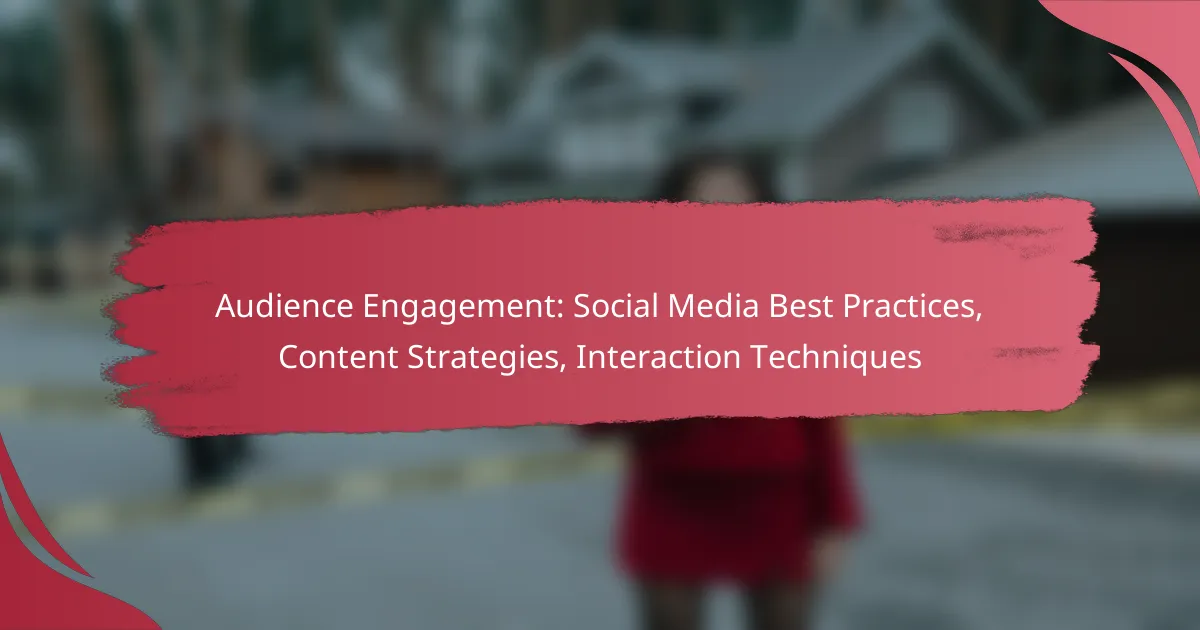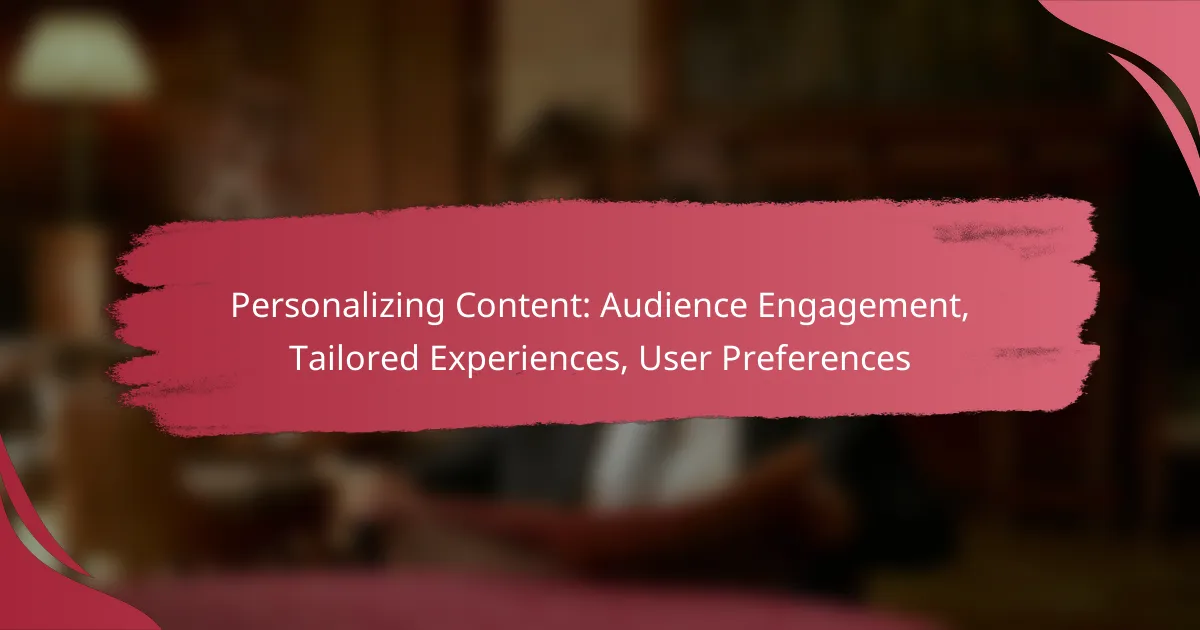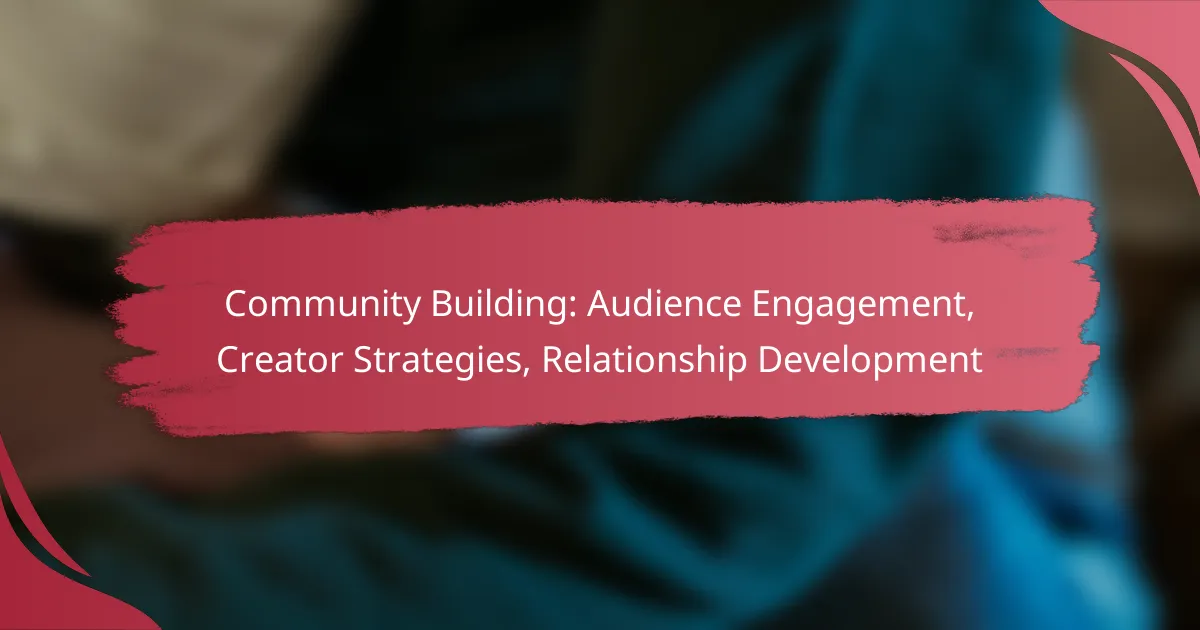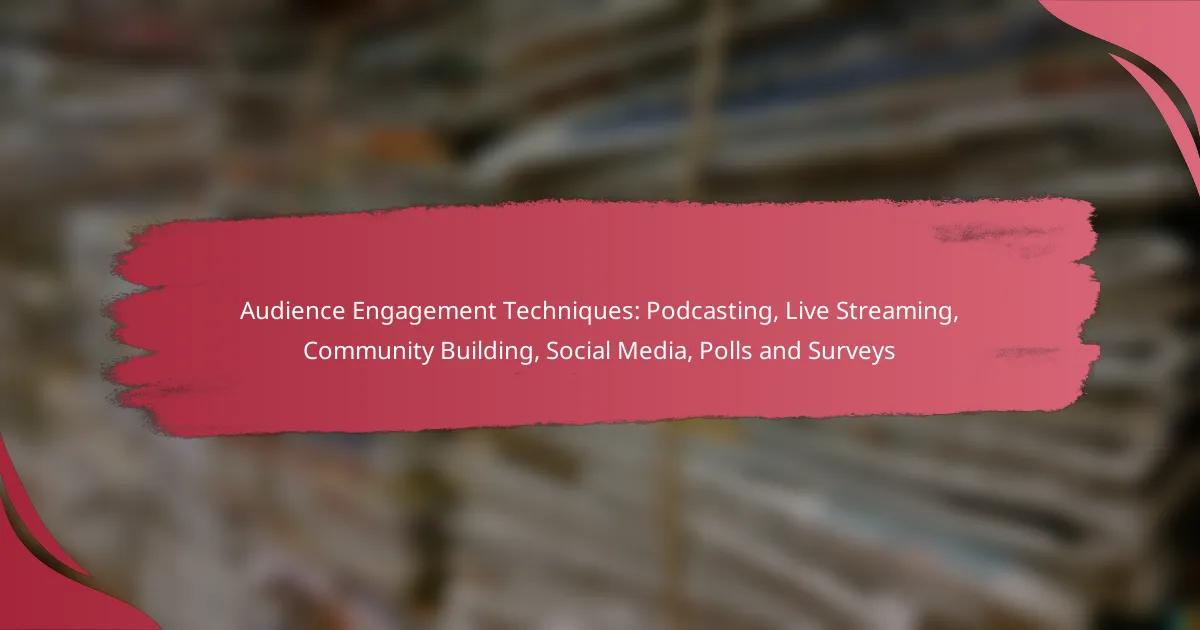Engaging your audience on social media requires a thoughtful approach to content creation and interaction. By understanding your followers and implementing strategic techniques, you can cultivate a lively community that not only enhances brand visibility but also fosters meaningful connections. Effective engagement involves timely responses, encouraging discussions, and personalizing interactions to create a dynamic online experience.
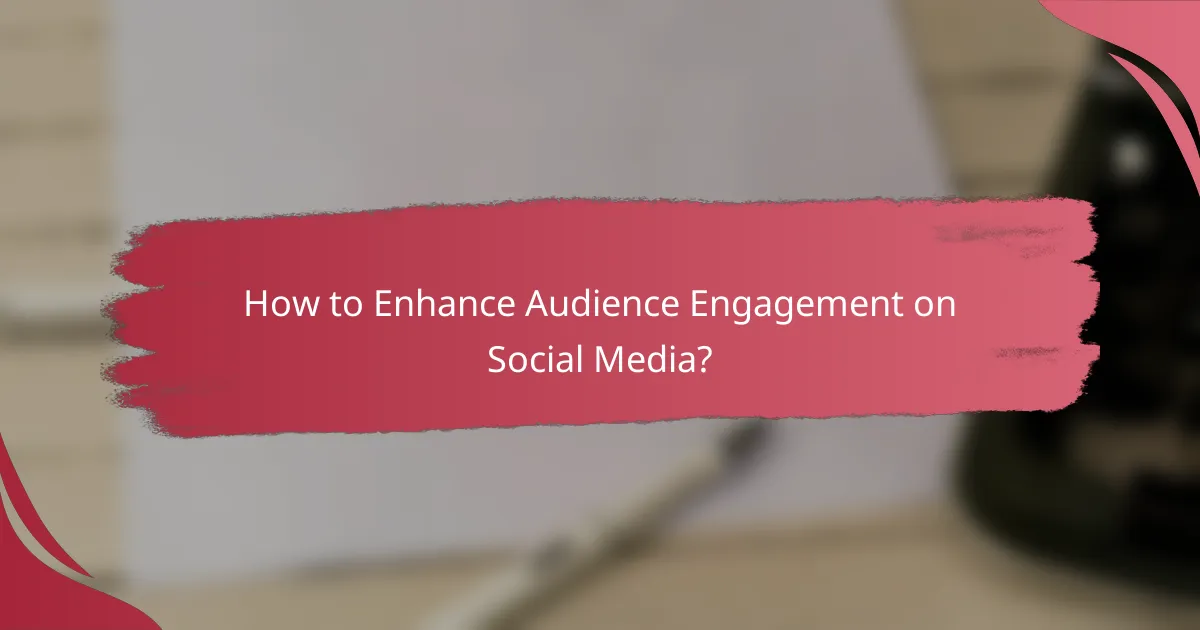
How to Enhance Audience Engagement on Social Media?
Enhancing audience engagement on social media involves creating content that resonates with your followers and encourages interaction. By implementing effective strategies, you can foster a vibrant online community and boost your brand’s visibility.
Utilize interactive content
Interactive content, such as quizzes, games, and contests, can significantly increase audience engagement. This type of content invites users to participate actively rather than passively consuming information.
Consider using tools like Instagram Stories or Facebook polls to create engaging experiences. For example, a fun quiz related to your brand can encourage shares and comments, expanding your reach and visibility.
Leverage user-generated content
User-generated content (UGC) is an effective way to enhance engagement by showcasing your audience’s creativity. Encouraging followers to share their experiences with your products or services can build community and trust.
Feature UGC on your social media channels by reposting customer photos or testimonials. This not only acknowledges your audience but also provides authentic content that resonates with potential customers.
Implement live video sessions
Live video sessions create real-time interaction opportunities, allowing audiences to engage directly with your brand. This format can humanize your brand and foster a sense of community.
Plan regular live sessions to discuss topics relevant to your audience or to host Q&A sessions. Promote these events in advance to maximize participation and engagement during the broadcast.
Conduct polls and surveys
Polls and surveys are simple yet effective tools for engaging your audience and gathering valuable feedback. They encourage participation and can provide insights into your audience’s preferences and opinions.
Use platforms like Twitter or Instagram to conduct quick polls. Keep questions straightforward and relevant to your brand to ensure high response rates and meaningful engagement.
Share behind-the-scenes content
Behind-the-scenes content offers a glimpse into your brand’s personality and operations, fostering a deeper connection with your audience. Sharing this type of content can humanize your brand and make it more relatable.
Consider posting photos or videos of your team at work, product development processes, or company events. This transparency can enhance trust and encourage followers to engage more with your brand.
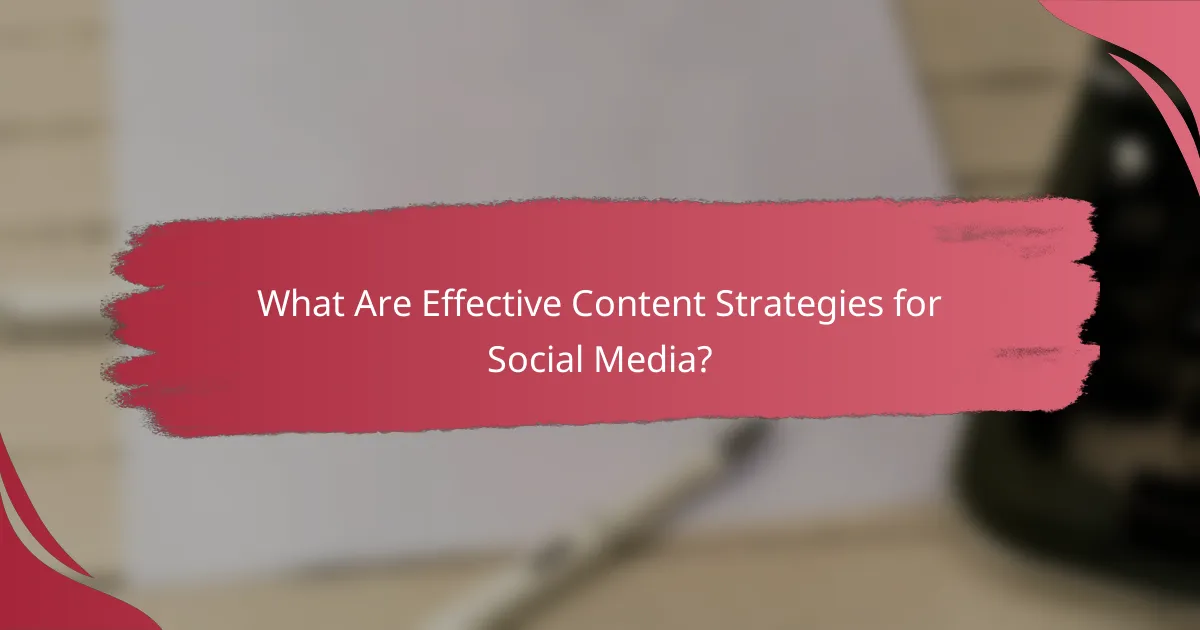
What Are Effective Content Strategies for Social Media?
Effective content strategies for social media involve planning, creativity, and audience understanding. By utilizing a structured approach, brands can enhance engagement, build community, and drive conversions.
Develop a content calendar
A content calendar is essential for organizing and scheduling posts across various platforms. It helps ensure a consistent posting frequency, which can improve audience retention and engagement. Aim to plan content at least a month in advance, allowing for timely adjustments based on trends or events.
Include key dates, such as holidays or product launches, in your calendar. This will help you align your content with relevant themes and maximize visibility. Tools like Google Calendar or dedicated social media management software can streamline this process.
Focus on storytelling
Storytelling is a powerful way to connect with your audience on social media. By sharing relatable narratives, brands can evoke emotions and foster a sense of community. Use anecdotes, customer testimonials, or behind-the-scenes glimpses to create compelling stories that resonate with your followers.
Consider the structure of your stories, ensuring they have a clear beginning, middle, and end. This approach not only captivates your audience but also encourages them to share your content, expanding your reach organically.
Use visuals and infographics
Visual content, including images and infographics, significantly enhances engagement on social media. Posts with visuals are more likely to be shared and remembered, making them an essential component of your strategy. Aim for high-quality images and clear, informative infographics that convey your message effectively.
When creating visuals, ensure they align with your brand’s aesthetic and messaging. Tools like Canva or Adobe Spark can help you design eye-catching graphics without requiring advanced design skills.
Tailor content for each platform
Each social media platform has its unique audience and content preferences. Tailoring your content for platforms like Instagram, Facebook, Twitter, and LinkedIn can significantly improve engagement. For instance, use visually appealing images for Instagram, while LinkedIn may require more professional and informative posts.
Consider the format and length of your content as well. Short, punchy posts work well on Twitter, while longer, in-depth articles may perform better on LinkedIn. Analyze your audience’s behavior on each platform to refine your approach and maximize impact.

What Interaction Techniques Improve Engagement?
Interaction techniques that enhance audience engagement include timely responses to comments, fostering discussions, hosting Q&A sessions, and personalizing interactions. These methods create a more dynamic and participatory environment, encouraging users to connect more deeply with the content and the brand.
Respond to comments promptly
Responding to comments quickly shows your audience that you value their input. Aim to reply within a few hours, especially during peak engagement times. This not only boosts the likelihood of further interaction but also builds a sense of community around your brand.
Consider using tools that notify you of new comments or questions to ensure timely responses. Avoid generic replies; instead, address specific points made by the commenter to foster a more meaningful dialogue.
Encourage discussions in posts
Encouraging discussions in your posts can significantly increase engagement. Ask open-ended questions or invite opinions on relevant topics to stimulate conversation. This approach not only keeps your audience engaged but also provides valuable insights into their preferences and thoughts.
To facilitate discussions, consider using polls or prompts that require users to share their experiences. Highlighting user comments in follow-up posts can also encourage more people to join the conversation.
Host Q&A sessions
Hosting Q&A sessions allows for direct interaction between you and your audience, making them feel more connected. Schedule these sessions regularly, whether weekly or monthly, and promote them in advance to maximize participation. Use platforms like Instagram Live or Facebook to reach a wider audience.
Prepare a list of common questions in advance, but remain flexible to address spontaneous inquiries. This not only showcases your expertise but also demonstrates your willingness to engage with your audience’s concerns.
Personalize interactions
Personalizing interactions can significantly enhance audience engagement. Use names when responding to comments or messages, and tailor your responses based on user behavior or preferences. This creates a more intimate connection and makes users feel valued.
Consider segmenting your audience based on their interests or demographics to provide more relevant content and responses. Small gestures, like acknowledging a user’s previous contributions, can go a long way in building loyalty and encouraging ongoing interaction.

What Metrics Measure Social Media Engagement?
Social media engagement can be measured through various metrics that reflect how users interact with your content. Key metrics include likes, shares, comments, click-through rates, and follower growth, each providing insights into audience behavior and content effectiveness.
Track likes and shares
Likes and shares are fundamental indicators of content popularity. A high number of likes suggests that your audience appreciates the content, while shares indicate that users find it valuable enough to distribute within their networks. Aim for a balanced approach; while likes are important, shares can significantly expand your reach.
To effectively track these metrics, use social media analytics tools that provide insights into engagement rates. Compare the number of likes and shares across different posts to identify what resonates most with your audience.
Analyze comments and mentions
Comments and mentions offer qualitative insights into audience sentiment and engagement. Monitoring comments allows you to gauge reactions and gather feedback, while mentions can highlight brand awareness and user-generated content. Encourage discussions by asking questions in your posts to increase comment volume.
Utilize sentiment analysis tools to categorize comments as positive, negative, or neutral. This can help you understand public perception and adjust your content strategy accordingly.
Monitor click-through rates
Click-through rates (CTR) measure how effectively your content drives traffic to your website or landing pages. A higher CTR indicates that your audience finds your calls to action compelling. Aim for a CTR of 1-3% as a general benchmark, but this can vary by industry.
To improve CTR, ensure your links are clearly visible and relevant to the content. A/B testing different headlines or visuals can help determine what prompts more clicks.
Evaluate follower growth
Follower growth reflects the expanding reach of your brand on social media. A steady increase in followers indicates successful engagement strategies and content resonance. Monitor follower growth over time to identify trends and assess the impact of your campaigns.
To foster follower growth, regularly post engaging content and interact with your audience. Consider running targeted ads to attract new followers, especially if you’re launching a new product or campaign.

What Are the Best Practices for Social Media Advertising?
Best practices for social media advertising involve understanding your audience, testing your content, and optimizing your campaigns for engagement. By implementing targeted strategies, you can enhance your ad performance and achieve better returns on investment.
Define target audience clearly
Clearly defining your target audience is crucial for effective social media advertising. Start by identifying demographics such as age, gender, location, and interests. This information helps tailor your messaging and ensures it resonates with the right people.
Utilize audience insights from social media platforms to refine your target groups. For example, Facebook allows you to create custom audiences based on user behavior and preferences, which can significantly improve your ad relevance.
Use A/B testing for ads
A/B testing, or split testing, involves running two variations of an ad to determine which performs better. This method allows you to experiment with different headlines, images, or calls to action to see what resonates most with your audience.
When conducting A/B tests, ensure you have a clear hypothesis and run tests for a sufficient duration to gather meaningful data. A common practice is to test one variable at a time to isolate its impact effectively.
Monitor key performance indicators such as click-through rates and conversion rates to evaluate the results. Aim for a statistically significant sample size to make informed decisions about your advertising strategies.
